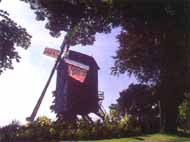|
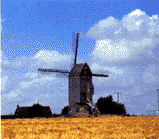
A few windmills still
survive
|
Obsolete
Like Kent and other cereal-growing regions of the UK,
Nord/Pas-de-Calais once had thousands of traditional
mills.
1,200 windmills were counted in this windswept region in the
early 19th century.
But towards the end of the 19th century,
these naturally-powered stone-grinding mills began to be
rapidly abandoned.
Steam powered mills
They were forced out of business by new technology. Massive
new mills were powered by coal-fired steam engines, which
could run day-and-night.
|
|
These new mills were in the industrial
cities like Lille, or the ports like Dunkerque - where they
could get cheap coal and supplies of imported grain from
newly opened farming regions like America and Russia.
They could deliver their flour all over
France using the network of railways and canals, rather than
the horse and cart..
|
|
Traditional cereal
farming
  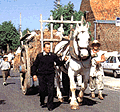
1.
Painting: “The Blessing of the Corn in Artois" by
Jules Bretton (1827-1906) in 1857.
2.
Today: recreating the 19th
century corn harvest, using horse-drawn reaper.
3.
Today: celebrating the role
of the heavy horse, the backbone of farm transport in the
19th century.
Not just flour
Windmills also ground animal feed, and crushed oil-seeds to
make the essential lighting oil before petroleum. Waterpower
was used to drive machinery in many industries - see
watermills.
|
Back to
top
|
The typical north French
post-mill
|
|
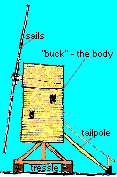
|
Most mills in north France are “post
mills”, which have a large body - the “buck”
- that can be turned round to make the sails face the wind.
The body swivels on a massive pivot fixed in the ground -
held steady by a tripod base, called a “trestle”.
When the wind direction changes, the miller has to turn the
mill round by pushing the tailpole - or he might get a horse
to do the work.
Often the base is covered over to protect
it from the weather and make an extra store room.
|
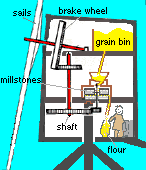
|
Back to
top
|
War
Windmills were often built on a hilltop - they made an ideal
lookout post. So in wartime, mills were often a deliberate
target. Few of these flimsy and neglected structures
survived.
Restoration
Fortunately over the last 20 years "A.R.A.M.", the region's
organisation of mill enthusiasts, has been able to protect
and restore about 40 of the few dozen surviving mills -
which you can now visit.
|
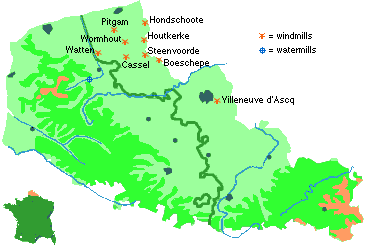
MAP: Wind- and water-mills you
can visit in Nord - Pas-de-Calais
|
|
Back to
top
|
|

|
Other types of
windmill:
(1) Tower mills
These were built with a fixed body of solid brick or stone.
Only the top cap turns round to make the sails face the
wind. This can be done with a tail-pole, or taller mills may
have an automatic device called a fantail.
|

Tower mill at Watten, built with stone from the local
monastery.
|

|
(2) Smock Mill
These also have a fixed body, a
timber-framed tower, covered in painted wood planks. Only
the top cap turns round to make the sails face the
wind.
Smock mills are common in Kent and
Holland, but not in Nord Pas-de-Calais. Windmills of this
type were used to drain the coastal marshes in the 16th
century.
|

Les Moëres - formerly a marshy lake near
Hondschoote
below sea-level. It was drained in the 17th century by Dutch
engineers who dug a “ring-dyke” round the edge,
then used windmills to pump out the water into the
dyke.
|
Back to
top
www.theotherside.co.uk
© Copyright 1999-2000 Invicta
Media Last updated 26th September 2000










